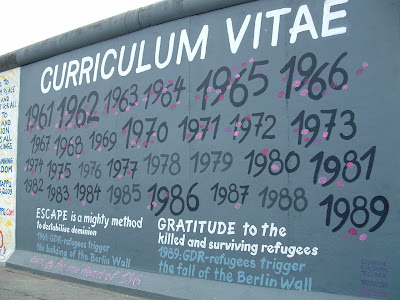We were back in first class for our five hour train ride from Amsterdam to Berlin. We enjoyed having a compartment where we could stretch out. Occasionally we would step out into the hallway and open a window, feeling the fresh air and smelling the countryside passing by.
Kevin recognized the name of this Dutch town we stopped in from his grandparent's diaries of their European trips. His grandfather's brother served in the Canadian army in World War II and was killed in the "Dieppe raid" of 1942. He is buried in the Canadian army cemetery outside Deventer.
We soon struck up a conversation with a Dutch woman who shared our compartment for part of our trip. Her English was limited, but we had a pleasant conversation which soon turned serious as we spoke of her memories of World War II and the German occupation.
We arrived in Berlin during the late afternoon rush hour and took the "U-Bahn" (the Berlin subway) to our hotel. This was a bit challenging to negotiate because our route had several detours and
"wir don't sprechen Deutsches".
Our hotel was on Kurfurstendamm ("Ku'damm") Boulevard, known as "the Champs Elysees of Berlin" in the 1800's, and the main commercial boulevard through former West Berlin.
By now it was my turn to catch our European cold. I rested in the hotel while Kevin and Laura went off in search of a laundromat. This challenging excursion included first figuring out the Berlin street numbering system (the numbers on one side of the street seem to have no relation to those on the other) and then the high-tech laundromat (with instructions only in German, of course).
By the afternoon we were ready to explore Berlin. We started at the "Topography of Terror".
This outdoor museum is built on the rubble where the headquarters of the Gestapo and SS stood. A long outdoor exhibit documents the rise and fall of Hitler and the Nazis, as well as Berlin in the postwar era. It runs parallel to one of the few remaining sections of the Berlin Wall.
Laura straddles the Wall, on what was once the dividing line between East and West Berlin.
Next we walked over to "Checkpoint Charlie", the famous border checkpoint between the former American and Soviet sectors in Berlin. We toured the nearby "Museum of the Wall", where exhibits tell the history of the Wall and the dramatic stories of some very ingenious escape attempts.
We walked down Unter den Linden, one of the grand boulevards in pre-World War II Berlin, to the Brandenburg Gate. This is the only surviving gate of the 14 original gates in the old city wall.
The Berlin Wall used to stand very close to the Brandenburg gate. Its former path is marked by bricks.
The Reichstag, home of the German parliament, looked impressive in the setting sun. Unfortunately it was closed, but we were still able to admire the outside, including the newer glass cupola on top, added in 1999 when the building was remodeled and reopened after a long period of neglect.
Laura and Mary walking through Tiergarten on our way to dinner. The Tiergarten is "Berlin's Central Park", stretching from the Brandenburg gate out through former West Berlin.
We ended our very long day with a traditional German meal: potato soup, bratwurst and mashed potatoes, goulash with spaetzle and beer!
Saturday we rode the U-Bahn out to the East Side Gallery. This is the longest surviving stretch of the Berlin Wall, running alongside the Spree River (and the former "No-Man's-Land" adjacent to it).
The paintings on this section of the Wall express the time of change and the feelings
of great hope -- a memorial to freedom.
"S-Bahn" train crossing the Spree River. Berlin has two metro systems: the "U-Bahn" is the underground subway, the "S-Bahn" is mostly above ground.
Later in the day we returned to central Berlin. It's interesting to walk through the former East Berlin and imagine what the large concrete buildings housed (or what the small sentry gate was for).
We visited the recently-opened (2005) Memorial to the Murdered Jews of Europe. It's thought-provoking, and perhaps intentionally disorienting, as you wander through the labyrinth of slabs.
We ended our stay in Berlin with a visit to the top of the "TV Tower", a momento of the Communist era, built to symbolize the East's superiority over the West, but now turned into a tourist attraction.
We saw the night lights of Berlin spread out before us, including a brief display of fireworks.
























